Caves in Crete
Diktaion Andron cave (Lasithi)
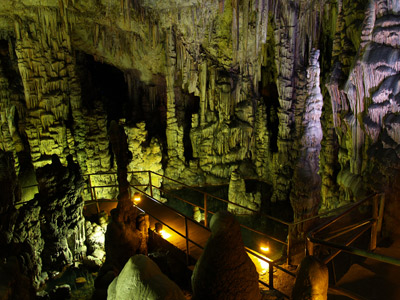
Diktaion Andron is one of the most important caves in Cretan island. It is located at Lasithi plateau near Psihro village. According to Greek mythology Rea had resorted there to give birth to Zeusin order to save him from his father who wanted to kill the young boy for fear of losing his kingdom due to his successor. Diktaion Andron cave was an inaccessible place to moral people until 4 young men, Laios, Kerveros, Aigolos and Keleos arrived there, dressed in clothing made of copper so as to avoid being bitten by bees, as they intended to steal some honey they would find at this place. When Zeus saw of them, he throw thunders on them and they would have died hadn't it been for the prohibition of killing anybody in the place of Diktaion Andron cave.
Cretans had been visiting the holly cave to worship Zeus and offer him valuable ablations for more than thousand years.
Excavations carried out by an Eglish archeologist, David Hogarth, have brought to light plenty of human and animal figurines, guns, tools and double-axes (sacred symbols). Diktaion Andron cave consists of two "rooms" with a tabernacle roof, a small lake and many stalactites. As the stalactites mix together with stalagmites, they look like cloth gofers, known as Zeus' mantle.
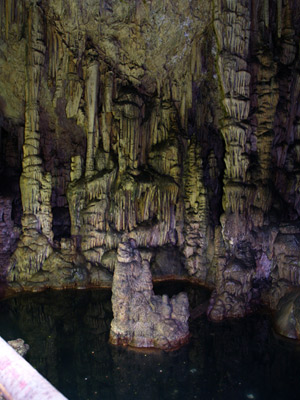
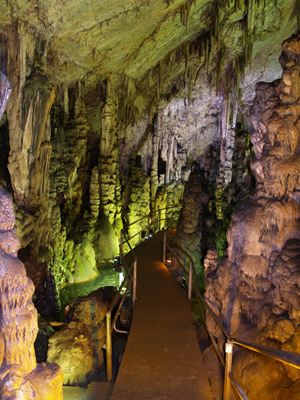
If you would like to visit this cave, you have to start from the tourist kiosk at Psixro village and ascent the foot-walk towards Lasithi plateau. It takes around 20 minutes to arrive at the entrance of the cave. Descending in the cave you will see a huge cavity to which the light arrives through the cave entrance while the walls are covered by stalactites in various sizes and shapes. Walking inside this cave you will get impressed by the view of stalagmites miraculous carved by the nature as wall as stalactites hanging from the ceiling creating an even more exciting scenery.
Zeus was said to take his bath in the small lake which is among the stalagmites. He is considered to have been born in the lateral chamber where most of the dedicatives have been found.
On the right side of the lake, a big, imposing stalactite hanging from the roof has shaped the Zeus' mantle. It looks as if big pillars have been built in that cave in order to decorate its back side.
Arkoudospilia cave
If you are in Chania town, in Crete island, then you can go to Akrotiri area on the east part of the town where you will find the Gouvernetou Monastery. A path that begins from that place ends at an impressive and magnificent gorge called Avlaki. After having walked for fifteen minutes you will arrive at Arkoudospilia (Bear's cave).
There is a small church devoted to Panagia Arkoudiotisa at the entrance of the cave.
However, the most exciting thing you can see in that cave is a big white stalagmite in a bear shape. Its height is 2.5 meters and it is really imposing in the gloom of the cave. According to mythology, a bear had been fossilized by Madonna at this place.
Inscriptives featuring Apollo and Artemis have been found in this cave where possibly Ancient Greeks used to worship Artemis, known in that case as "Arkoudothea" (which means a "bear-goodness" because of the bear-shaped stalagmite). Christians have devoted this cave to Madonna to whom they have also given a designation related to the bear: "Panagia Arkoudiotissa". It derives from the Greek term for bear "arkouda".
Elithia's cave
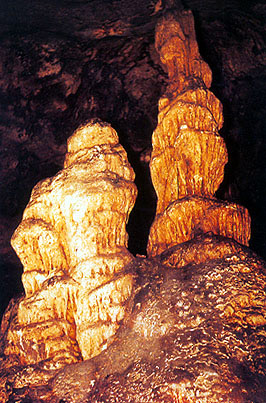
Elithiaís cave is located between Heraklion and Agios Nikolaos towns, on the west part of Crete island. To begin with, Elithia is the name of an Ancient Greek goodness who was Zeusís and Heraís daughter. Cretans used to worship her as the protector of child-bearing women and as a result they consigned pregnancy related offerings to Elithia, which were found in her cave by excavators.
When you enter that cave, you will see a hill-like stalagmite that reminds of a pregnant womanís belly. There is also a small bowl in the center of it, the navel. Child-bearing women had to rub lightly their belly on that point because it was believed that this would help them to give a good birth.
Some meters away, you will see the ruins of a small old building as well as stalagmites and pillars in the centre of the cave. There is also another building at this point, where you will find a group of human-like stalagmites. The niches of the cave walls are decorated with water collecting basins. This place is full of conches spread everywhere in it.
Gortynos cave
Gortynos cave is located near the Ancient part of Gortyna town. This cave has been related to Minos, an Ancient Cretan king, and to his labyrinth where Minotaur lived. According to the myth, an Ancient Greek god, Poseidon was angry with Minos because the king didnít fulfill a promise to the god and as a result Poseidon punished by having Minoís wife making love with a bull. She bore then Minotaur, a freaking child that had a human head while his body was that of a bull. Minotaur lived in that cave which was a labyrinth, until Theseus, an Ancient Greek hero, killed him.
Archeologists argue on which cave was, in fact, the Minotaurís labyrinth, (providing this legend is true) as several Labyrinths have been found in Crete island. It is also said that the labyrinth had been constructed by Daidalus, an Ancient Greek architect. If you walk in that cave, you have to follow a round route from one chamber to another while exits leading to other rooms exist in each chamber. You will pass through Aridnessís chamber, the woman who helped Theseus to exit the labyrinth by giving him a yarn, the chamber where the fighting between Theseus and Minotaur took place, the chamber where Minotaur used to dinner etc. Mind the routes because you may get lost in it!
Saint Paraskeviís cave
It is located near Skotino village in a distance of 21 km away from Heraklion city. It had been used as a worship place by Ancient Greeks. Christians built a church devoted to Saint Paraskevi, at the entrance of the cave. They arrive there to celebrate the Saintís name day each year, on 26 July.
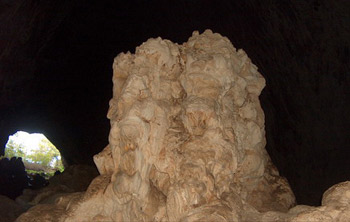
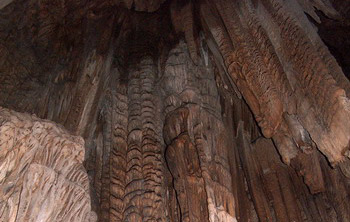
The first chamber of this cave is full of stalactites hanging from the ceiling or from its walls. What is really impressive, at first sight, is the height of that ceiling which is almost 50 meters. Heavy-weight rocks decorated with stalagmites grace the floor while two stalagmites attract the visitorís attention: the first looks like a womanís head and it is 8 meters high. The second is 11 meters high and looks like a human body. They both are considered to have been used as worship idols during Minoan period.
The chambers of this cave are in different levels and conches are spread on the floor. You can smell the humidity in the air while feeling an imposing atmosphere created by the silence that dominates among the plethora of various shaped stalactites and stalagmites of the dark cave.
Sfedoniís cave
It is one of the most impressive caves in Greece. Its surface is bigger than 3,400 m2 and it consists of many chambers decorated with stalagmites and stalactites which create various shapes, such as big pillars that look to have been constructed by talented architects. Stalagmites have turned to huge delicate sculptures over the years. Sometimes they are conjunct to the stalactites creating glyphic walls. Some of them are human-shaped but you can see plenty of strange shapings in this endless cave.
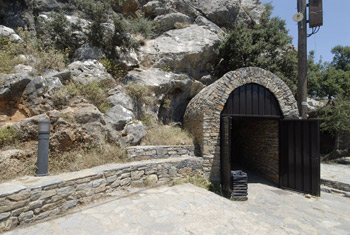
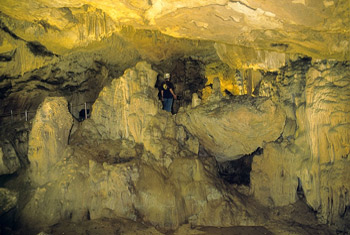
Sfedoniís cave could be a great source of inspiration for many artists (painters, architects, decorators, sculptors, photographers) as well as for all of as who visit it and feel charmed by its imposing beauty.
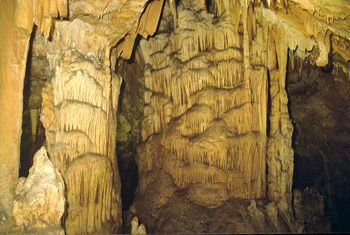
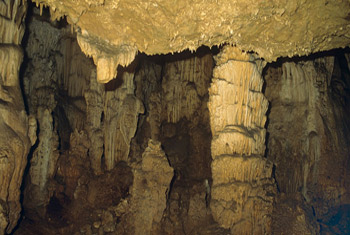
If you ever visit Crete island, do not omit to go hiking to that cave. It is located near Zoniana village. Bear in mind that you need at least a map or a local person to guide you to the cave because it is so big, with different chambers and corridors as well as slippery paths, that you may get lost!
Idaion Adron cave
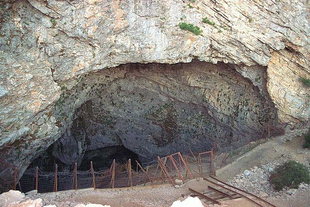
This cave is located at Idi Mountain (known as Psiloritis) and is the second cave that pretends the right to be considered as Zeusís birth place. Excavations in it have brought to light copper shields and other guns and tools, ivory objects, conches, animal bones and inscriptives which prove that this place was a worship place where sacraments were carried out during ancestry.
The entrance of the cave is gallant and you have to descent a path to get into the first chamber. The cave is divided in different chambers by big stalagmite and stalactite pillars and nature has taken care of its decoration by shaping human-like stalactites. You can reach Idaion Adron cave from Anogeia, from Rethymno or from Heraklion, via a road that connects them.





